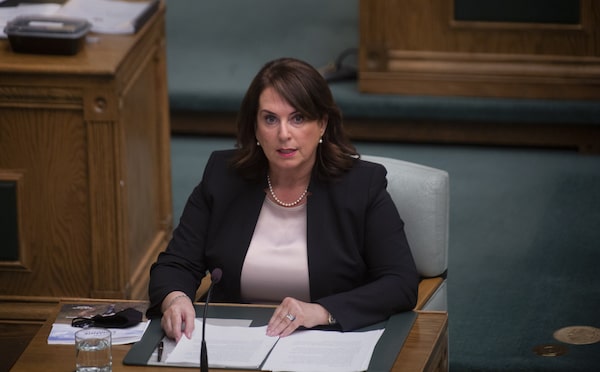
Newfoundland and Labrador Minister of Finance Siobhan Coady presents the 2021-22 provincial budget in St.John's on May 31, 2021.Paul Daly/The Canadian Press
Newfoundland and Labrador forecast a $351-million deficit in its spring budget tabled on Thursday, projecting a significant drop in oil royalties for the 2022-23 fiscal year at a time when oil prices are skyrocketing.
Provincial net debt is to hit $17.1 billion, which works out to about $32,700 per person in the province of about 522,500 people.
The budget for the 2022-23 fiscal year shows that the province’s deficit in the previous fiscal year totalled $400 million – a notable decrease from the $826 million estimated in last spring’s budget.
Called “Change is in the air,” this year’s budget unveils a commitment to amalgamate the province’s four regional health authorities and increase spending in health and education.
Finance Minister Siobhan Coady summed up the budget with one word: “Balance.”
With no increase in taxes and a 50 per cent cut to vehicle registration costs, the budget strikes an even keel between hammering down the provincial debt and helping residents weather the increasing cost of living, Coady told reporters.
“We don’t want to have austerity budgets,” she said during a news conference in St. John’s. “We want to get to a place where Newfoundland and Labrador is sustainable.”
The province has long struggled with staggering debts and deficits, but Coady said Thursday her government is on track to hit a surplus in the 2026-27 fiscal year. That forecast “will only get better,” she said, as the province works out a benefits agreement for a controversial new oil project approved by Ottawa.
Federal Environment Minister Steven Guilbeault green-lit Equinor’s Bay du Nord offshore development project on Wednesday evening, despite vehement opposition from climate scientists and environmentalists.
The company initially estimated there were about 300 million recoverable barrels of oil at the project site, which sits about 500 kilometres off the coast of St. John’s. But more discoveries have been made and industry experts say there could be more than 800 million barrels out there.
Meanwhile, the budget projects some of the lowest oil revenues the province has seen in years. Oil royalties – at about $866 million – will account for just 10 per cent of the province’s revenues in the 2022-23 fiscal year. That’s down from $2 billion in 2011-12.
The dip in oil revenue is the result of a drop in production, which Energy Minister Andrew Parsons largely attributed to planned maintenance and shutdowns in the province’s four oilfields.
Parsons told reporters discussions were still active about whether his government would buy a stake in the Bay du Nord project if it ultimately goes ahead, but he played down any enthusiasm about it.
“We go through COVID, we go through an industry beat down do you want to bet on that or not?” he asked, referring to the pandemic-related pounding inflicted on the oil sector and its subsequent recovery, as the war in Ukraine drives soaring fuel prices.
Health Minister John Haggie said the decision to fold the four provincial health authorities into one is driven largely by a desire for efficiency and better care.
“This is about enhancing front-line services and spending our money wisely,” Haggie told reporters. He couldn’t put a figure on how much money the province might save from the amalgamation, which he said was likely to happen within the next 18 months.
He admitted there may be job losses, but insisted the move wasn’t about “mass layoffs.”
The budget earmarks $14 million for efforts to recruit and retain nurses and doctors, and it includes $10 million to overhaul the emergency room at the Health Sciences Centre in St. John’s.
The Newfoundland and Labrador Medical Association has said around 90,000 people in the province are without a family doctor.
The province is seeing an increase in K-12 students for the first time in decades, with an expected jump in enrolment of about 1,000 children. The budget allotted an extra $11.6 million for teaching services to meet that demand.
Coady said the population has jumped by about 2,800 people – a big number in a province used to residents moving away for better jobs and deaths outpacing births. Pandemic-related remote work options have allowed some of those people to move home, she said.
With $1 million in the budget for “immediate supports” for Ukrainian refugees who choose to settle in Newfoundland and Labrador, she said the government hopes that number will go up.
Our Morning Update and Evening Update newsletters are written by Globe editors, giving you a concise summary of the day’s most important headlines. Sign up today.